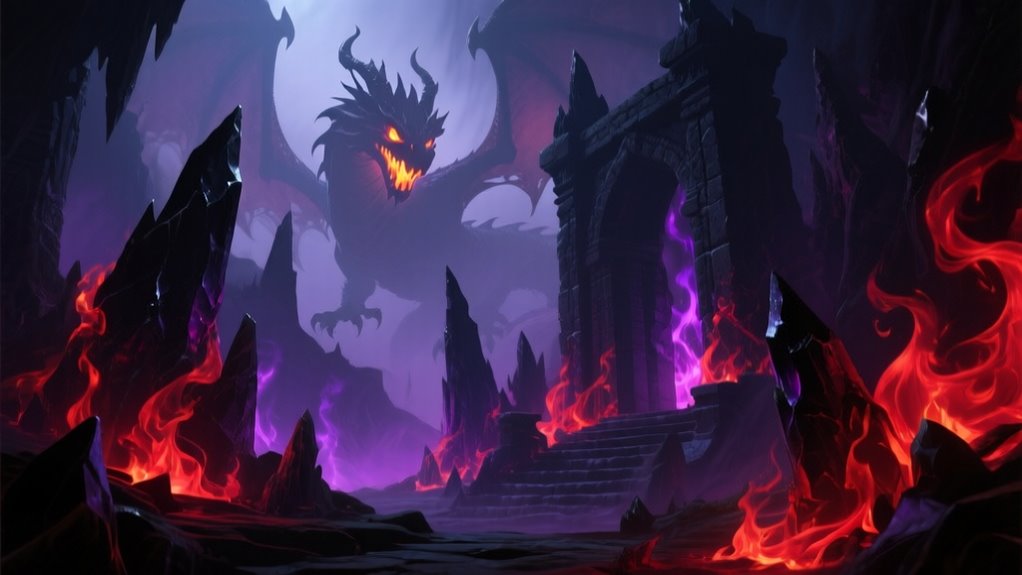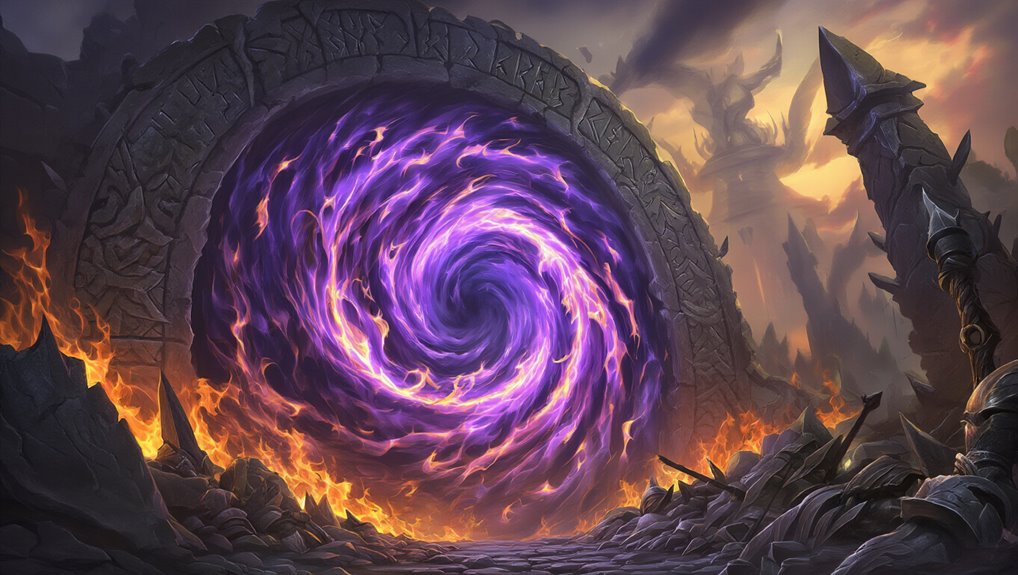Origins of Shadowflame in WoW
Though the origins of Shadowflame might seem shrouded in mystery, its roots are firmly embedded in the tumultuous history of Azeroth.
 As you delve into its shadowflame origins, you'll uncover that this potent force is a blend of dark magic and draconic fire, a combination that first emerged during the Black Dragonflight's corruption. This dark magic, believed to be a fusion of shadow and fire elements, was harnessed by Deathwing, the aspect of Death, who sought to imbue his followers with unimaginable power.
As you delve into its shadowflame origins, you'll uncover that this potent force is a blend of dark magic and draconic fire, a combination that first emerged during the Black Dragonflight's corruption. This dark magic, believed to be a fusion of shadow and fire elements, was harnessed by Deathwing, the aspect of Death, who sought to imbue his followers with unimaginable power.
In the cataclysmic events following the War of the Ancients, Shadowflame was unleashed upon the world, leaving a trail of destruction and chaos. It's not merely a weapon; it's a testament to the catastrophic potential of unchecked magic. Understanding Shadowflame requires a deep dive into Azeroth's past, where the lines between elemental forces and forbidden arts blur, creating a legacy of fear and awe.
Key Figures Associated With Shadowflame
As the legacy of Shadowflame unfolds, it's impossible to ignore the key figures who've shaped its fearsome history. Among these notable characters, Nefarian stands out. The eldest son of Deathwing, Nefarian was instrumental in the shadowflame origins, blending dark magic with dragonfire to create this deadly force. His experiments with chromatic dragons showcased the destructive potential of shadowflame, cementing his place in its lore.
Another pivotal figure is Sinestra, Nefarian's mother. She delved deep into forbidden magics, enhancing her offspring's dark magic pursuits. Her influence perpetuated the spread of shadowflame, further entwining it with the sinister legacy of the Black Dragonflight.
Lastly, the Twilight's Hammer cult played a crucial role. Their reverence for shadowflame as a tool of chaos underscored its allure to those seeking power. These figures collectively forged shadowflame's path, leaving an indelible mark on its sinister history.
The Role of Shadowflame in Azeroth's History
In the annals of Azeroth's tumultuous history, shadowflame has played a transformative role, acting as both a weapon of devastation and a catalyst for conflict. First unleashed by the malevolent dragon Nefarian, shadowflame was a perverse blend of shadow magic and fire, possessing the capability to bypass traditional resistances and scorch even the most resilient of defenses. Throughout the ages, whispers of shadowflame myths have circulated, recounting battles where its destructive force turned the tide of war. These tales include the legendary Shadowflame Artifacts, relics imbued with this dark energy, sought by power-hungry factions eager to wield or contain their potential.
The history of shadowflame is steeped in the ambition and hubris of those who dared to control it, from the Black Dragonflight's experiments to the twisted machinations of warlocks. Its presence in Azeroth's lore underscores the eternal struggle between creation and ruination.
Shadowflame in Gameplay Mechanics
While exploring the multifaceted world of Azeroth, players encounter shadowflame as a potent force within the gameplay mechanics of World of Warcraft (WoW). This unique energy combines shadow and fire elements, creating fascinating spell interactions and shadowflame damage mechanics that challenge even the most seasoned players. Shadowflame's presence in the game is not just a visual spectacle but a strategic tool requiring keen understanding. Here are four emotional touchpoints that highlight its impact:
- Anticipation: As you prepare for a raid, knowing that shadowflame spells could turn the tide of battle, creating a thrilling sense of anticipation.
- Triumph: Successfully harnessing shadowflame damage mechanics to defeat formidable bosses brings a rush of victory.
- Frustration: Experiencing the devastating power of enemy shadowflame spells can test your resolve and strategy.
- Mastery: Mastering shadowflame spell interactions is both a satisfying and daunting accomplishment, enriching your WoW journey.
Shadowflame's Influence on Factions and Races
When you examine Shadowflame's historical impact on Azeroth, you can't ignore its role in shifting Horde relations, particularly during the rise of Deathwing's influence. The Alliance, perceiving Shadowflame as a direct threat, has often reacted with skepticism and hostility, further complicating inter-faction diplomacy. Meanwhile, the infusion of Shadowflame into specific races, like the Twilight's Hammer cultists, has markedly altered racial power dynamics, granting them destructive capabilities that challenge the balance of power across the world.
Impact on Horde Relations
Though the Shadowflame's origins trace back to the tumultuous events of Blackrock Mountain, its reverberations have profoundly impacted the intricate tapestry of Horde relations. The allure of Shadowflame has led to:
- Horde unity fractures: Warlock factions vie for dominance, creating rifts.
- Shadowflame alliances: New pacts form, upsetting traditional power dynamics.
- Diplomacy challenges: Trust erodes as suspicions rise among key leaders.
- Conflict escalation: Power struggles threaten to engulf the Horde in chaos.
These challenges require a nuanced influence assessment to mend the damage. As distrust festers, the Horde's cohesion stands threatened, demanding immediate reconciliation efforts. Navigating these perilous waters necessitates not only strategic foresight but a commitment to rebuilding trust, ensuring the Horde doesn't fall prey to its own internal conflicts.
Shadowflame and Alliance Tensions
Despite the ongoing turbulence within the Horde, the Shadowflame's influence extends beyond, casting a long shadow over Alliance tensions. Historically, the Shadowflame conflict has intensified the Alliance's internal power struggles, reshaping diplomatic negotiations among its factions. With the ever-present threat of Shadowflame alliances, leaders like Anduin Wrynn have had to recalibrate their Alliance strategy to counteract potential infiltration and betrayal.
Alliance factions, each with their own agendas, find themselves at crossroads, debating how best to address this dark power's looming threat. The dwarves of Ironforge, known for their resilience, push for military action, while the night elves advocate for a more cautious approach, highlighting the need for strategic unity. The Shadowflame's pervasive influence remains a catalyst for discord and urgent collaboration.
Racial Power Dynamics Shift
As the Shadowflame weaves its insidious tendrils throughout Azeroth, it catalyzes a seismic shift in racial power dynamics, particularly within the Horde. You witness racial alliances fracturing as the Shadowflame amplifies existing power struggles. Historically, the orcs and trolls have led the Horde with brute strength and mysticism. However, Shadowflame's influence has awakened dormant ambitions in other races. Consider:
- The Forsaken, long in the shadows, now vie for dominance, seeking autonomy from orcish leadership.
- The Blood Elves, rejuvenated by magical energies, aspire to reclaim a central role, leveraging their arcane prowess.
- The Tauren, driven by ancient traditions, resist change, fostering internal discord.
- The Goblins, opportunists at heart, exploit chaos, prioritizing profit over unity.
In this volatile landscape, alliances teeter on the brink.
The Future of Shadowflame in WoW Lore
As you explore the future of Shadowflame in WoW lore, consider its potential to reshape Azeroth's narrative through new storyline developments and dynamic characters. Historically, Shadowflame has served as a catalyst for tension among factions, and its resurgence could introduce innovative roles that challenge traditional power structures. With such changes, you might also anticipate a profound impact on game mechanics, possibly introducing fresh mechanics or revamping existing ones to reflect Shadowflame's evolving influence.
Potential Storyline Developments
While the Shadowflame has long been a sinister force intertwined with the darker chapters of Azeroth's history, its potential to shape future storylines in World of Warcraft is immense. Imagine the unfolding of a shadowflame prophecy, foretelling cataclysmic events. You might witness a shadowflame resurgence, where forgotten shadowflame artifacts are unearthed, sparking chaos. Shadowflame cults could rise, their dark rituals threatening to engulf Azeroth in flames. The chilling shadowflame visions might haunt heroes, guiding them—or deceiving them—down perilous paths. Consider the emotional weight of shadowflame alliances, where uneasy truces with nefarious forces become necessary for survival. The following developments could evoke:
- Fear as the prophecy unfolds.
- Despair from artifact-driven chaos.
- Tension in cult-driven narratives.
- Intrigue in unexpected alliances.
New Characters and Roles
In the shadow of looming prophecies and rising cults, new characters are poised to emerge in World of Warcraft's evolving shadowflame narrative. These characters promise enriched role exploration, delving deeper into the enigmatic shadowflame lore. Historically, figures like Deathwing and Cho’gall have wielded shadowflame, but future narratives hint at fresh faces and unexpected alliances. With the introduction of these new characters, WoW's storytelling could shift, exploring untapped potential.
Character Name Role Exploration Historical Context
| Zarith Flameweaver | Cult Leader | Influenced by Cho’gall’s teachings |
| Vala the Veil | Shadowflame Sorceress | Emerges from Deathwing’s legacy |
| Tharok the Warden | Guardian | Protector of ancient shadowflame secrets |
These additions could redefine alliances and rivalries, echoing Azeroth’s tumultuous past.
Impact on Game Mechanics
Though often considered an enigmatic force, shadowflame's integration into World of Warcraft's game mechanics signals a significant evolution in gameplay dynamics. This arcane blend of shadow and flame offers a rich tapestry of strategic depth. Historically, shadowflame abilities have emerged as a pivotal component in boss encounters, altering how players approach combat. Shadowflame interactions redefine your role in battle, demanding adaptation and quick thinking.
Consider these emotional impacts:
- Excitement: Discovering new shadowflame abilities that reshape your gameplay.
- Challenge: Mastering shadowflame interactions that test your tactical skills.
- Nostalgia: Remembering epic battles where shadowflame turned the tide.
- Anticipation: Awaiting future expansions that may delve deeper into shadowflame's mysteries.
Shadowflame is not just a tool—it's a transformative force enhancing WoW's narrative complexity.
Frequently Asked Questions
Can Shadowflame Be Resisted or Blocked by Any Spells or Abilities?
You’ll find that 20% of players speculate on shadowflame resistance mechanics. Historically, shadowflame spell interactions suggest limited resistance possibilities, as few abilities mitigate its effects, making it a formidable challenge in battles due to its unique properties.
Are There Known Artifacts That Amplify the Power of Shadowflame?
Yes, there are artifacts like the Scepter of Sargeras that amplify Shadowflame. Historically, these Shadowflame artifacts have played pivotal roles, affecting events through their destructive power. Understanding Shadowflame history unveils their deep influence on Azeroth's past.
How Does Shadowflame Interact With Other Elemental Magics?
Shadowflame's synergy with other elemental magics often disrupts elemental balance. Historically, when combined with elements like fire or void, it creates volatile reactions, amplifying destruction. Detailed chronicles reveal its unpredictable nature, challenging even seasoned spellcasters.
What Are the Visual Effects of Shadowflame in Different Environments?
In each setting, shadowflame's colors burst forth like a kaleidoscope in chaos, painting the ground with eerie hues. Shadowflame effects are mesmerizing, weaving through landscapes, casting ancient shadows that whisper tales of forgotten realms and untold power.
Has Shadowflame Ever Been Used for Purposes Other Than Destruction?
You've seen shadowflame used beyond destruction, especially in shadowflame healing and shadowflame rituals. Historically, its chaotic energy has paradoxically mended wounds and been central to rituals that balance power, illustrating its complex role throughout Azeroth's history.

